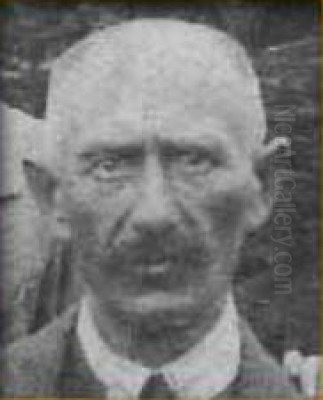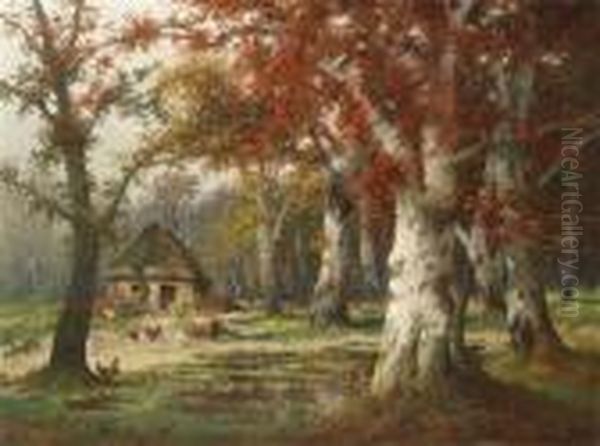
Adolf Kaufmann stands as a significant figure in Austrian art history, particularly renowned for his evocative landscape and marine paintings. Spanning a career that bridged the late 19th and early 20th centuries, Kaufmann captured the natural beauty of Austria and beyond with a distinctive style influenced by European realism yet touching upon the atmospheric concerns that would lead towards Impressionism. His work, appreciated by critics, collectors, and royalty alike, offers a window into the artistic currents of his time, particularly his connection to the influential Barbizon School and the vibrant art scene of Vienna.
Early Life and Artistic Formation
Born on May 15, 1848, in the town of Opava, then part of Austrian Silesia (now in the Czech Republic), Adolf Kaufmann displayed an early aptitude for art. While details of his initial training remain somewhat scarce, it is known that he pursued formal artistic education to hone his natural talents. A pivotal moment in his development came when he traveled to Paris, the undisputed center of the art world in the 19th century. There, he sought instruction to refine his skills in landscape painting, a genre gaining new prominence and approaches.
In Paris, Kaufmann studied under Emile van Marcke de Lummen (often cited simply as Emile van Marcke), a respected painter known for his landscapes and, particularly, his depictions of cattle, himself influenced by the Realist tradition and artists like Constant Troyon. This mentorship was crucial. Van Marcke's emphasis on careful observation of nature, combined with the prevailing artistic winds in France, deeply impacted Kaufmann's developing style. He absorbed the lessons of French Realism and, significantly, the ethos of the Barbizon School.
The Influence of the Barbizon School
The Barbizon School, active roughly from the 1830s to the 1870s near the Forest of Fontainebleau in France, represented a move away from idealized Neoclassical landscapes towards a more direct, truthful depiction of nature. Artists like Jean-Baptiste-Camille Corot, Théodore Rousseau, Charles-François Daubigny, and Jean-François Millet sought to capture the specific moods, light, and atmosphere of the landscapes they observed firsthand, often painting en plein air (outdoors) to achieve greater immediacy.

Kaufmann was profoundly influenced by this approach. He embraced the concept of the "paysage intime" – the intimate landscape – focusing on capturing the character and atmosphere of specific natural settings rather than grand, historical panoramas. His works often feature tranquil woodland scenes, meandering streams, quiet ponds, and rural pathways. He demonstrated a keen sensitivity to the changing effects of light and weather, using color and tone to evoke particular times of day or seasons. This dedication to capturing the essence of the natural world aligns closely with the Barbizon painters' goals.
Kaufmann's Artistic Style: Realism and Atmosphere
Adolf Kaufmann's style is primarily rooted in Realism, characterized by a commitment to depicting subjects truthfully and objectively. However, his interpretation of Realism was infused with a lyrical quality and a strong sense of atmosphere, reflecting the Barbizon influence. His brushwork, while detailed, often retained a certain looseness, allowing for expressive textures, particularly in rendering foliage, water surfaces, and skies. He possessed a sophisticated understanding of color, employing a rich palette to convey the vibrancy of nature.
A notable feature of Kaufmann's landscapes is his skillful use of light and shadow (chiaroscuro) to create depth and drama. High contrasts often define his compositions, highlighting the play of sunlight filtering through trees or reflecting off water. While predominantly a landscape painter, Kaufmann frequently included small figures – peasants, walkers, or farm animals – within his scenes. These figures are typically integrated harmoniously into the environment, adding a sense of scale and narrative interest without dominating the natural setting, a technique also employed by many Barbizon artists.
Subjects and Travels
While deeply connected to his Austrian homeland, Kaufmann's artistic vision extended beyond its borders. He traveled extensively throughout Europe, seeking diverse landscapes to paint. His oeuvre includes scenes not only from Austria (like the Vienna Woods or the Salzkammergut region) but also from France, particularly Normandy and Brittany, known for their dramatic coastlines and picturesque countryside. He also painted in Holland, capturing its distinctive flat landscapes, canals, and windmills, and explored motifs in Germany and Poland.
His marine paintings often depict coastal scenes with fishing boats, harbors, or seascapes under varying weather conditions. Whether painting tranquil forests, rugged coastlines, or serene waterways, Kaufmann consistently demonstrated his ability to capture the unique character and mood of each location. His works often convey a sense of peace and solitude, inviting viewers to contemplate the quiet beauty of the natural world. He frequently returned to themes of forests, rivers, and lakes, exploring them in different seasons and light conditions.
Career in Vienna and Recognition
After his formative years and travels, Kaufmann established himself in Vienna, which was then the thriving capital of the Austro-Hungarian Empire and a major European cultural hub. He became an active participant in the city's art scene, regularly exhibiting his works. His paintings were shown at prestigious venues such as the Vienna Künstlerhaus (the main exhibition hall for established artists), the annual exhibitions at the Glaspalast in Munich, and the Great Berlin Art Exhibition.
Kaufmann's talent did not go unnoticed. His works gained considerable popularity among art collectors and the public. He received accolades for his paintings, including medals at international exhibitions. A significant honor was receiving an award at the Paris World Exhibition (Exposition Universelle) of 1900, a testament to his international standing. His appealing style and technical skill also attracted patronage from high society, including members of the aristocracy and even royalty. Sources mention collectors such as Princess Stéphanie of Belgium (wife of Crown Prince Rudolf) and various Archduchesses of the Habsburg court, indicating his favor among elite circles.
Connection to the Vienna Secession
Interestingly, Adolf Kaufmann is also associated with the Vienna Secession movement, although his style differs significantly from the group's most famous proponents like Gustav Klimt or Egon Schiele. The Vienna Secession, founded in 1897 by artists who broke away from the conservative Künstlerhaus, aimed to promote modern art, embrace international styles (like Art Nouveau, known as Jugendstil in German-speaking countries), and break down barriers between fine and applied arts. Key figures included Klimt, Koloman Moser, Josef Hoffmann, and Joseph Maria Olbrich.
Kaufmann's connection seems to stem from his participation in Secession exhibitions or his alignment with the broader goal of artistic renewal, rather than a stylistic adherence to Jugendstil. His landscape painting, while rooted in Realism, possessed a modern sensibility in its focus on mood and atmosphere, sometimes referred to as "Stimmungsimpressionismus" (Mood Impressionism) in the Austrian context. This focus on subjective feeling and atmospheric effect resonated with some aspects of the Secession's broader artistic explorations, even if his technique remained more traditional than that of the core Secessionists. His involvement highlights the diverse range of artists associated with this pivotal Viennese movement.
Teaching and the 'Art School for Ladies'
Beyond his personal artistic practice, Adolf Kaufmann contributed to art education in Vienna. Recognizing the limited opportunities available for women to receive formal art training at the time, he co-founded a private art school specifically for female students around 1890. He established the "Malerschule für Damen" (Painting School for Ladies) in collaboration with fellow artists Carl von Merode (a genre and landscape painter) and Heinrich Lefler (a painter and stage designer associated with the Secession).
This initiative was significant, providing a dedicated space for women to develop their artistic talents under professional guidance. It reflected a growing awareness of the need for equal access to art education. Kaufmann's role as a teacher and mentor further cemented his position within the Viennese art community and contributed to the development of the next generation of artists, particularly women painters who were increasingly making their mark, such as Tina Blau, Olga Wisinger-Florian, and Marie Egner, contemporaries who also excelled in landscape and atmospheric painting.
Use of Pseudonyms
An interesting aspect of Kaufmann's career was his occasional use of pseudonyms. Besides signing works with his own name, he is known to have used variations or different names, possibly for commercial reasons, to differentiate stylistic experiments, or to participate in different markets or exhibitions without overexposing his primary identity. Some documented pseudonyms include A. Guyot, M. Bandouch, L. Bayer, L. Bauer, J. Rollin, F. Herink, G. Salvi, J. Grombeck, and A. Papouschek. Recognizing these pseudonyms is important for attributing works that might otherwise seem disconnected from his main body of work. This practice was not uncommon among artists of the period seeking broader market reach.
Representative Works
While Kaufmann was prolific, identifying specific "masterpieces" can be challenging as many works are in private collections. However, certain titles and types of scenes are representative of his output:
Forest Landscapes: Paintings like "Stream in the Vienna Woods" or "Autumn Forest" showcase his skill in rendering dense foliage, dappled light, and the textures of the forest floor. These often feature a central path or stream leading the viewer's eye into the composition.
Coastal Scenes: Works depicting the coasts of Normandy or Brittany capture the interaction of sea, sky, and land, often featuring fishing boats or coastal villages under dramatic lighting conditions. "Coastal Scene in Normandy" is a typical subject.
Austrian Landscapes: Many paintings capture the specific beauty of Austrian regions, such as "Farmstead in Lower Austria" or views of the Salzkammergut lakes, emphasizing tranquility and rural life.
River and Lake Scenes: Subjects like "Am Bach" (By the Stream) or views of tranquil lakes reflect his mastery of water reflections and peaceful, atmospheric settings.
Winter Landscapes: Kaufmann also painted snow scenes, effectively capturing the muted light and specific atmosphere of winter.
His works consistently demonstrate strong composition, a harmonious color palette, and an ability to convey the mood and spirit of the place depicted.
Later Life and Legacy
Adolf Kaufmann remained active as a painter well into the 20th century. He continued to live and work primarily in Vienna, where he died on November 25, 1916. By the time of his death, the art world was undergoing radical transformations with the rise of Expressionism and abstraction, yet Kaufmann's work retained its appeal, representing a continuation of the strong landscape tradition influenced by 19th-century Realism and Impressionism.
Today, Adolf Kaufmann's paintings are held in various public and private collections across Europe and beyond. Notable museum holdings include the Leopold Museum in Vienna, which houses a significant collection of Austrian art from this period, as well as museums in his birthplace, Opava (formerly Troppau), and the Istanbul Museum of Art, reflecting his international reach. His works frequently appear at auctions, appreciated by collectors for their technical quality and evocative beauty.
His legacy lies in his contribution to Austrian landscape painting, skillfully blending the observational rigor of Realism with the atmospheric sensitivity of the Barbizon School and Mood Impressionism. He stands alongside other important Austrian landscape painters of his era, such as Emil Jakob Schindler (a key figure in Austrian Mood Impressionism) and Robert Russ. Kaufmann's dedication to capturing the nuances of nature, his role in the Viennese art scene, including his connection to the Secession and his efforts in art education, secure his place as a respected and significant artist of the Austro-Hungarian Empire. His paintings continue to offer viewers a sense of connection to the natural landscapes he so masterfully depicted.